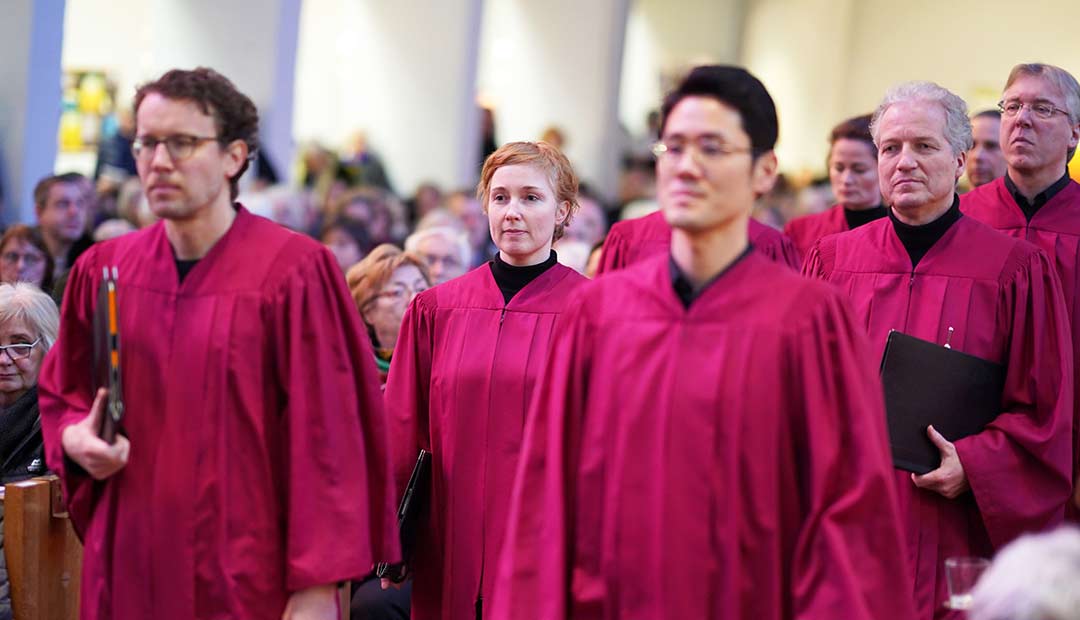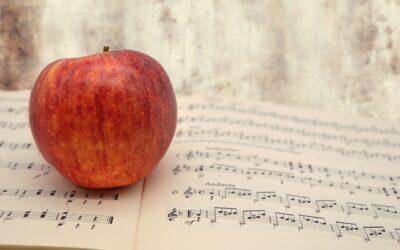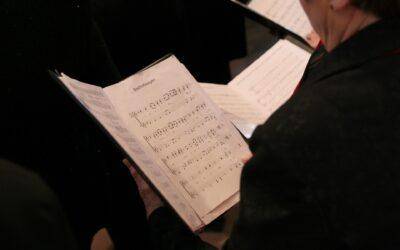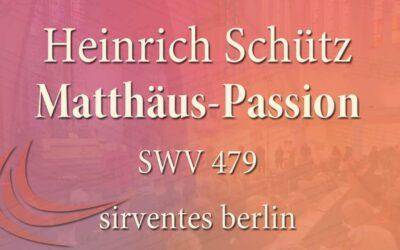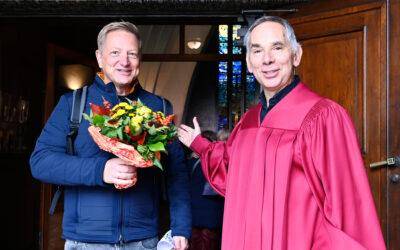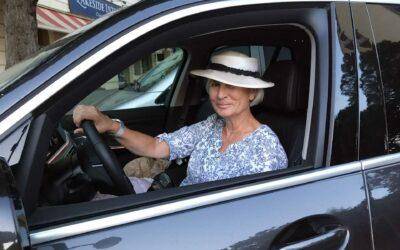The Noon Song – the sounding gift for mind and soul. Those seeking the healing power of sounds and melodies will direct their steps to the church Am Hohenzollernplatz on Saturday at noon. From the Psalms to centuries-old chorales and motets to contemporary compositions, the restorative power of sacred music penetrates the heart and mind, always a pleasure, comfort and joy for the whole person.
Christhard-Georg Neubert – Art Commissioner of the Evangelical Church Berlin Brandenburg – Silesian Upper Lusatia
Lecturer for choral literature
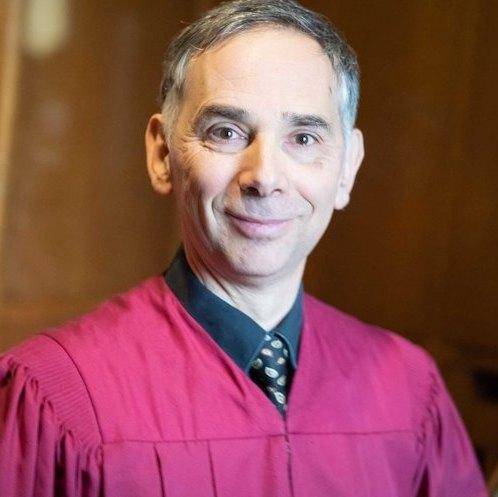
As a lecturer in choral literature at the UdK Berlin, I often stood in the reading room of the music libraries in front of the monument and complete editions. In the opulent, expensively bound series “The Heritage of German Music” with 125 volumes, and other large-format series, I came across large-scale, magnificent church music from the Middle Ages, Renaissance and Baroque periods that I had never heard of before.
There were no recordings of many of the works, although they were transcribed into perfectly legible modern musical notation in the scholarly editions. An even greater treasure trove are the old complete editions produced from the 19th century onwards.
An astonishing number of settings of psalms and magnificats by Protestant composers, often multi-choral and with many instruments, were among them, and I began to wonder in what social and liturgical context these works might have been heard.
Trinity College Cambridge
I got some answers to my questions during a visit to Trinity College Cambridge, where I was a guest of the choral conducting professor there, Richard Marlow. There I experienced the daily Evensongs performed by the college choir. The choir sang psalm settings every day at the highest level in a wide variety of ways, from Gregorian chant to simple “Anglican chants” to highly virtuosic motets, and a Magnificat composition every day.
Evensong has preserved the tradition of the choral Liturgy of the Hours, which was regularly celebrated in the Protestant and Catholic churches in Central Europe until the 19th century.
Daily Evensong
At the same time, I was thrilled to see how the daily Evensong shapes people: the choir has to be incredibly fast and attentive in order to be able to sing new works ready for performance every day, the visitors are motivated by the glorious singing to make their congregational singing sound just as beautiful, and everyone lives naturally in their musical tradition, which they explore and bring to life every day.
Not to mention, Evensong attracts many tourists every day, so the traditional college churches in Cambridge are always well attended. I left Cambridge with the wish to revive the chorally sung Liturgy of the Hours on a regular basis here as well – and in the conviction that this form is also good for people seeking peace and reflection in such a secular city as Berlin.
The NoonSong – continuation of a millennia-old tradition
The Evensong liturgy takes up the form of the daytime prayers as they were celebrated above all at the Latin schools and monasteries in Protestant Central Germany in the 16th century – a tradition that is only just being researched and opened up again
Liturgy of the day
The liturgy of the times of day with its strict church year connection is celebrated in a comparable way in all Christian churches and is thus an ideal form of ecumenical worship. From a musical point of view, it provides the original framework for the abundance of figural choral music also by Protestant composers, e.g. to the Cantica, which have no place in the Lutheran Mass, and thus enables the revival of this treasure.
For the visitors, the NoonSong is a “low-threshold offer” because they are primarily involved in the liturgy by listening. This role of the listener was already described by Samuel Sebastian Wesley in the course of the “Musical Renaissance” in the Anglican Church in the 19th century as follows: »In his view, those who actually performed the service could never be so thoroughly imbued with its spirits as those who preserved a silent attention. The beauty of choral service of the Church […] must necessarily render the auditor speechless, and produce a feeling far different from that which results in utterance.« (1)
Liturgical model
In preparatory discussions with, among others, the Catholic priest Prof. Dr. Andreas Odenthal, (Chair of Liturgical Studies at the Eberhard Karls University in Tübingen, now in Bonn) and former Bishop Prof. Dr. Wolfgang Huber, I developed the reconstruction and adaptation of the liturgical model. The formal brackets are the “Preces & Responses” of the Evensong in German translation. They enclose two psalms, the reading and the canticle and end with the respective weekly hymn. The psalm selection is based on the reading order of the “Evangelisches Tagzeitenbuch” with the respective daily and weekly psalms for the following Sunday.
Ringing of the bells
The ringing of the bells is like an invitation to a Sunday service. The eight singers in red choir robes, the conductor and the liturgist have taken up their positions at the back of the church. To the sound of the organ, the performers enter and take their places between the congregation and the altar steps. This makes it clear that the choir is acting on behalf of the congregation. He sings the “Preces” alternating between cantor, liturgist and choir according to the Anglican rite, which are composed of the invitatory and versicle of the Liturgy of the Hours.
Next, two psalm compositions, mostly in large-scale choral works, are heard from the chancel, on the daily and weekly psalms. As the only spoken word, the liturgist then recites the reading with a few introductory words, followed by the choir’s responsory in the form of German Gregorian chant. The Canticum is either a Magnificat or Benedictus composition or a setting of another hymnal text from the New Testament that is appropriate for the church season.
This is followed by the “Responses”. They consist of the Kyrie, the Our Father, in which the congregation joins in, the great intercessions alternating between the liturgist and the choir, and the three collect prayers, which the liturgist sings on a recitative note according to Anglican tradition. The short liturgy closes with the respective weekly hymn, sung alternately by the choir and congregation in several voices, and the blessing of the liturgist, and the choir departs again to the sound of an organ piece.
The tradition that has become tradition
Today, after almost 500 NoonSongs, the NoonSong itself has become a tradition that sets the rhythm of many people’s weekends. Looking back, I realise that the NoonSong has made a difference in the meantime. I don’t know any congregation that sings as well as the NoonSong congregation, full of verve and intonation, with pleasure also in several voices. The NoonSong continues to record growth in attendance after ten years, in stark contrast to the current trend in worship attendance in Catholic or Protestant congregations. Since the NoonSong has to manage without regular institutional funding from the state or the churches even after more than ten years, a unique form of active support has developed: the NoonSong only exists as long as people are committed to it. In this way, dependent on the approval of our visitors, we have openly accepted every discussion and suggestion, but have remained true to the traditional form. This is perhaps the most astonishing realisation: that millennia-old psalm texts sung in the greatest possible beauty within the framework of a liturgy rich in tradition still reveal the power of the Word of God today. (2)
1 Rainbow, Bernarr: The Choral Revival in the Anglican Church 1838–1872, London 1970, Neuaufl. Woodbrigde 2001
2 In the course of more than 10 years, over 400 different psalm compositions, over 50 different Magnificats and over 20 different liturgical settings were heard. s.a. Müller, Claudio: 30 Minuten Himmel – der Berliner NoonSong, in: Musica sacra 2018, S. 350–352

